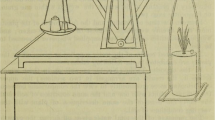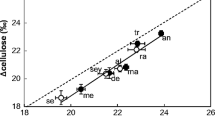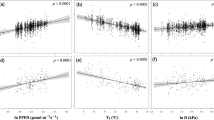Summary
Calorific values for the vegetative tissues of a group of perennial desert and arid woodland plants ranged from 3,191 to 5,375 calories per gram, oven dry weight. These span the range of comparable values reported earlier for plants in other environments, and reflect variety in adaptations to dry environments. Tissues with low values had high ash percentages, and contain significant amounts of low-energy oxalate salts. To interpret differences in calorific values for plants, one must understand: 1) the significance of calorific values in plant energetics, 2) the functions of compounds responsible for high and low values, and 3) the relative rates of metabolism and dry matter production for those plants.
Similar content being viewed by others
References
Arnott, H.J., Pautard, F.G.E.: Calcification in plants. In: Biological calcification (H. Schraer, ed.), p. 375–446. New York: Appleton-Century-Crofts 1970
Barrow, G.M.: Physical chemistry, 3rd ed. New York: McGraw-Hill 1973
Bliss, L.C.: Caloric and lipid content in alpine tundra plants. Ecology43, 753–754 (1962)
Couch, J.F.: The toxic constituent of greasewood (Sarcobatus vermiculatus). Amer. J. Pharm.94, 631–641 (1922)
Darling, M.S.: Structure and productivity of a pinyon-juniper woodland in northern Arizona. Ph.D. thesis, Duke University, Durham, N.C. (1966)
Dean, J.A. (ed.) Lange's handbook of chemistry, 11th ed. New York: McGraw-Hill 1973
Ganong, W.F.: Present problems in the anatomy, morphology, and biology of the Cactaceae. Bot. Gaz.20, 129–138, 213–221 (1895)
Gmelin's Handbuch der anorganischen Chemie, 8. Aufl., System-Nr. 22, Kalium, Lief. 5 Berlin: Verlag Chemie 1938
Gmelin's Handbuch der anorganischen Chemie, 8. Aufl., System-Nr. 28, Calcium, Teil B, Lief. 3. Weinheim: Verlag Chemie 1961
Gmelin's Handbuch der anorganischen Chemie, 8. Aufl., System-Nr. 21, Natrium, Ergänzungsbd., Lief. 4. Weinheim: Verlag Chemie 1967
Golley, F.B.: Energy values of ecological materials. Ecology42, 581–584 (1961)
Golley F.B.: Caloric value of wet tropical forest vegetation. Ecology50, 517–519 (1969)
Hadley, E.B., Bliss, L.C.: Energy relationships of alpine plants on Mt. Washington, New Hampshire. Ecol. Monogr.34, 331–357 (1964)
Jacobson, C.A.: Encyclopedia of chemical reactions, Vol. 6. New York: Reinhold 1956
Jordan, C.F.: A world pattern in plant energetics. Amer. Sci.59, 425–433 (1971)
Lieth, H.: Primary productivity of the major vegetation units of the world. In: Primary productivity of the biosphere (H. Lieth, R.H. Whittaker, eds.), Ecological studies, Vol. 14, pp. 203–215. Berlin-Heidelberg-New York: Springer 1975
Osmond, B.: Oxalates and ionic equilibria in Australian saltbushes (Atriplex). Nature (Lond.)198, 503–504 (1963)
Osmond, C.B.: Acid metabolism inAtriplex I. Regulation of oxalate synthesis by the apparent excess cation absorption in leaf tissue. Aust. J. biol. Sci.20, 575–587 (1967)
Paine, R.T.: Endothermy in bomb calorimetry. Limnol Oceanogr.11, 126–129 (1966)
Paine, R.T.: The measurement and application of the calorie to ecological problems. Ann. Rev. Ecol. Syst.2, 145–164 (1971)
Parkes, G.D.: Mellor's modern inorganic chemistry London: Longmans, Green 1951
Parr Instrument Company: Oxygen bomb calorimetry and combustion methods. Manual No. 130, Moline, Ill. (1960)
Parr Instrument Company: Instructions for semimicro operation of series 1240 oxygen bomb calorimeters. (Mimeograph) Moline, Ill. (1971)
Price, J.L.: Ultrastructure of druse crystal idioblasts in leaves ofCercidium floridum. Amer. J. Bot.57, 1104–1109 (1970)
Reiners, W.A., Reiners, N.M.: Comparison of oxygen-bomb combustion with standard ignition techniques for determining total ash. Ecology53, 132–136 (1972)
Scott, D.: The determination and use of thermodynamic data in ecology. Ecology46, 673–680 (1965)
Verduin, J.: Caloric content and available energy in plant matter. Ecology53, 982 (1972)
Weast, R.C. (ed.): Handbook of chemistry and physics, 55th ed. Cleveland, CRC Press 1974
Williams, M.C.: Effect of sodium and potassium salts on growth and oxalate content ofHalogeton. Plant Physiol.35, 500–505 (1960)
Author information
Authors and Affiliations
Rights and permissions
About this article
Cite this article
Darling, M.S. Interpretation of global differences in plant calorific values. Oecologia 23, 127–139 (1976). https://doi.org/10.1007/BF00557851
Received:
Issue Date:
DOI: https://doi.org/10.1007/BF00557851




